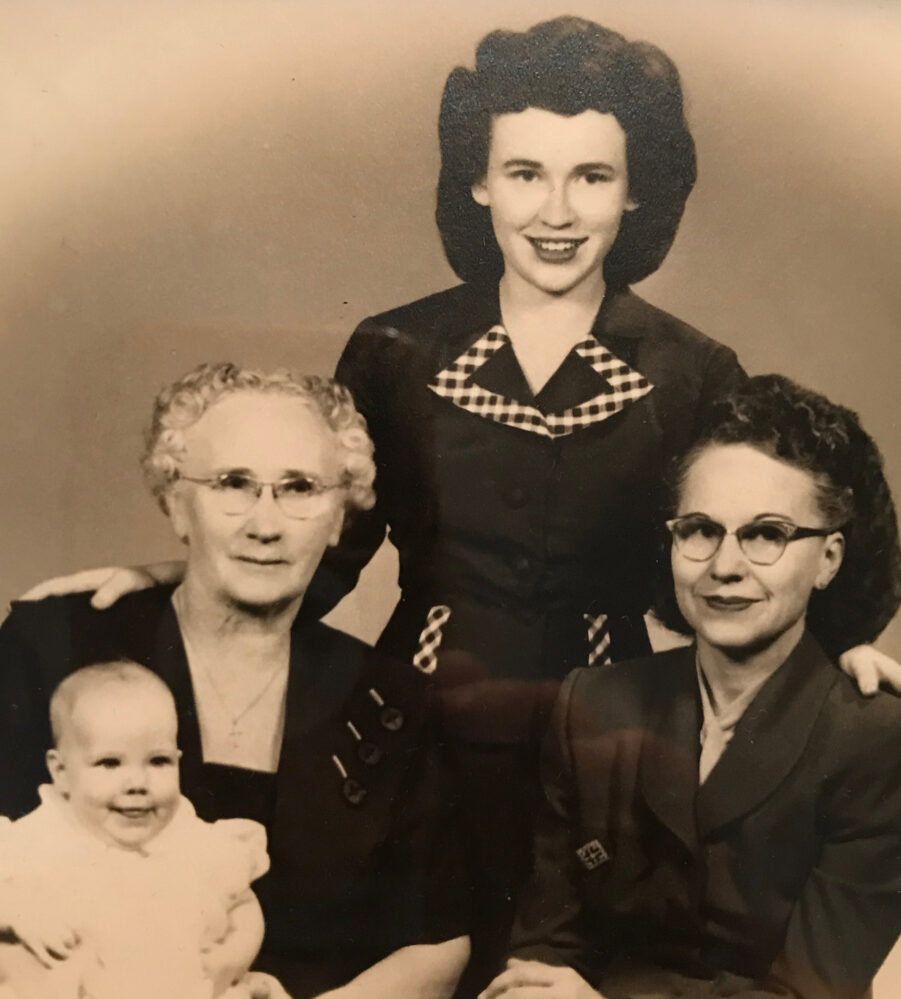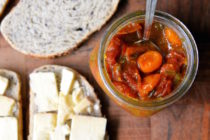A roast chicken has many lives, with end-of-meal relics that offer all kinds of future culinary assets. There are bones for making broth in the slow cooker, giblets and necks for gravy, shredded white and dark meat contribute to future casseroles and chicken salad … and the weird smidgins that I can’t identify? My dogs love those gnarly bits.
Nothing pleases me more than a freezer bulging with a few gallon Ziploc bags containing frozen chicken bones and onion heels rolling around amongst pie crusts, popsicles and what I refer to as back-up bacon.
Roast chicken and its tasty residuals make me feel like some sort of urban pioneer. In the moment I feel resourceful, useful. I feel like it’s 1932 and I’m my great-great-grandmother, on the prairie in Western Kansas, living in a dugout sod house, winning a few meals for the family. I like to think she’s smiling down on me, nodding and thinking to herself, “This one, she would survive hard times.”

But I know the truth. I shop at Costco two to three times a month for packaged organic toddler snacks and transfer all my bulk grains, beans and pasta into Le Parfait canning jars and terrines for, well, superficial aesthetic reasons. I’m barely able to survive without air conditioning.
I do not even have a deep freezer. But if I did it would be stacked with homemade broths in snap-lid jars. My husband isn’t a soup enthusiast, but I am. I eagerly make broth for my recipes, namely bean recipes, and for my dogs. I like to sauce their fancy kibble with a generous ladleful. I’ll heat some broth, frozen tortellini, fresh baby spinach and grated Parmesan into a quick soup lunch and have a coastal grandmother moment to myself with a cozy blanket. I romanticize the broth. And I know I’m getting every cent out of that carcass.
And the chicken itself? I’m a fan of Costco rotisserie chickens. I don’t have to roast one myself to respect the end product. I’ve dabbled in HEB’s rotisserie chickens, too, but I think the Costco version is slightly better.
But sometimes I like to buy a cold raw chicken in plastic instead of a hot cooked chicken in plastic. Yes, I pay the same amount for an uncooked bird – indeed, usually more. But there’s pleasure in making a pretty bed in the roasting pan of herbs and aromatics, massaging the little guy with butter and oil and slipping slivers of garlic under his skin, not to mention overheating my kitchen for 90 minutes. That’s a chicken with which I feel a true connection.
And I should have been content with what I know and love.
Why did I think I needed to dabble in some sort of chorizo-influenced roasted pollo recipe from people who seem to have never had a recipe checked, edited or reviewed by anything other than a bot?
Well, I was feeling festive, maybe. I like chorizo, the vinegary-spicy fresh Mexican sausage style. The recipe also called for potatoes and tomatoes, which seem, together, kind of wrong. But then I figured that if these recipe-writers do it, it must be okay. So, I compared a few recipes and stepped into the unknown. I deeply regretted it almost immediately. But I doubted myself, and kept thinking, “These food professionals must know something I don’t.”
When will I learn to trust myself? I know what my mother would say: These are bad recipes. No.
These recipes all called for only a dash of olive oil and no butter, on the bird. Which should have been a red flag. They also don’t mention adding more than two teaspoons of salt to the entire dish, which is upsetting, considering one of the recipes I referenced included four cups of baby potatoes. But I did actually use my pretty good judgement about these things and both salted (and peppered) and lovingly buttered the whole chicken.
Where was the flavor going to come from? One of the recipes called for 1/4 to 1/2 teaspoon of cayenne, which as a Texan, I felt was insane. (That particular recipe author is Canadian. Think about that.) Her recipe also listed 1 1/2 tablespoons of paprika, which she warned “might make the chicken look burned, but it isn’t. It’s just paprika!” Madame, the photo you showed looks like a pasty white chicken with one small roasted part on top. I’m guessing that’s the paprika. And that’s the only part I wanted to eat.
Two cloves of garlic with the papery skins still on? Only two?
One. Small. Onion.
WHAT? What’s this bird going to even taste like, especially after I dump two cups of sliced cherry tomatoes around it? The authors are promising smokey, hot, Spanish-y goodness. I’m hoping for anything edible.
I read the comments. “Yum! This was spicy and so good!” Are you sure, Allen in Utah? Have you ever had a roast chicken? Have you ever had chorizo?
One of the recipes requested no onions, but instead a halved lemon, which would do basically nothing for us. But I carried on. I cut the lemon in half, squeezed the juice on the chicken’s breast and obediently waited 15 minutes. (But why?)
The chicken looked so sad and smelled so much of nothingness that I stuck a small, sliced green jalapeño in its gaping hole. I had pilfered that chile from my parents’ refrigerator weeks ago. It was way past its prime, but it was a last-ditch effort to keep within the promised flavor profile and resurrect what I was beginning to fear would be a bland bird.
The most alarming part of my recipe gathering should have been the final cooking instruction on one recipe that stated the chicken was done once the internal temperature reached 185 degrees. Dear recipe-writer, chicken is done at 165 degrees. This chicken was not stuffed – which can require extra time in the oven – save for a wrinkly small jalapeño.
After 70 minutes I removed the chicken from the oven. and it looked wonderful. The tomatoes, however, were shriveled, watery and lame. The potatoes looked unadulterated, which is the exact opposite of how a cooked potato wants to look. But the skin on the bird was perfect, which I credit to my recipe-defying butter and oil method. Cutting into the thigh joint, juices ran out, because I don’t overcook my chicken, unlike one of these recipe authors.
Yet, sadly, it was the most flavorless chicken I’ve ever cooked, to the point of angering me. Is this what Midwestern chicken tastes like? Is this how my great-great grandmother had to suffer in 1932 when times were hard and carrots and onions and lemons were not available in the Dust Bowl?
In my mind, the chicken was an apt symbol of the bland, seasonless Caucasian food I’m disgusted with on social media. Hard thumbs down. The potatoes – some were still actually crunchy – were tossed in the trash. I tried to recover the pan juices to make a red, barely garlicky sauce in order to salvage this chicken, But as it turns out my husband “had a big lunch” that day and was already clearing the table.
As I dipped pieces of succulent but flavorless breast meat into a gravy boat of bland tomato water, I told myself I’d never let this happen to my household again and would continue worshipping at the roasted chicken recipe I’ve used time and time again.
As I write this, the bones are in the slow cooker, creating canine kibble broth.
Two of my favorite recipes, below, for an easy and fool-proof roast chicken.







Follow Us